St. Clair River AOC Projects' Highlights
- Marysville Living Shoreline Restoration
- Marin City Drain
- Cottrellville Township Shoreline Restoration
- Upper St. Clair River Shoreline Restoration and County Wetlands Park
Marysville Living Shoreline Restoration
This project reestablished vital fish and wildlife habitat along the St. Clair River, addressing the “Loss of Fish and Wildlife Habitat” BUI.
A total of 1,885 feet of steel seawall that was removed and replaced, created a stronger, natural shoreline. Planted wetland vegetation established a “living shoreline.” This made spawning and nursery habitat for Great Lakes fish. Birds and other wildlife also benefit from the development of the wetland and upland prairie vegetation. In addition, the upgrades made to the adjacent public walkway and boardwalk improved fishing and recreational access for the community and visitors.
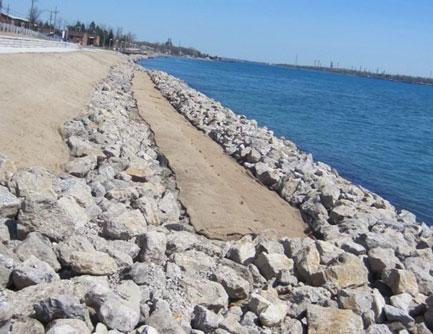 Marysville shoreline before restoration
Marysville shoreline before restoration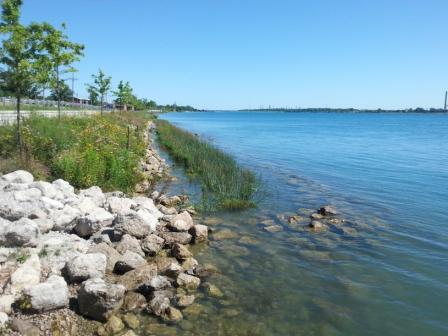 Completed Marysville shoreline restoration.
Completed Marysville shoreline restoration.
Marin City Drain
Restoration on the north side of the mouth of the drain and about 1,000 feet upstream, repaired the shoreline and restored near/shore habitat for fisheries, waterfowl, reptiles, and amphibians. The use of rock and woody structure, including some whole tress, restored the shoreline. Rock break walls provide cover and shelter for fish and amphibians, creating a calm water environment.
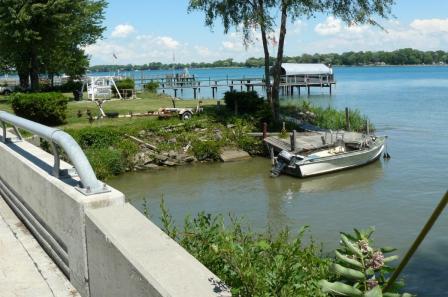 In 2014, degraded habitat along the Marine City Drain.
In 2014, degraded habitat along the Marine City Drain.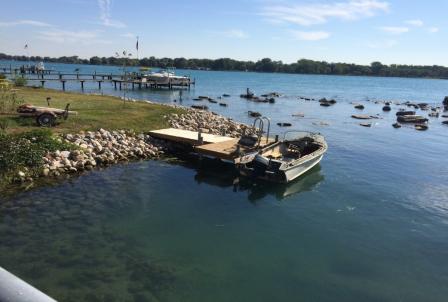 Marine City Drain after 2015 restoration.
Marine City Drain after 2015 restoration.
Cottrellville Township Shoreline Restoration
Before restoration began, the shoreline was littered with debris and had little habitat value. The habitat restoration in the St. Clair River AOC was completed within the riparian areas and along 500 linear feet of shoreline of the St. Clair River. The project objectives of this restoration achieved:
- improved native vegetation and riparian buffer;
- improved fish, macroinvertebrate, and amphibian diversity/population;
- erosion reduction;
- improved stability of the shoreline to enhance the shallow water and near shore habitat;
- wetlands establishment.
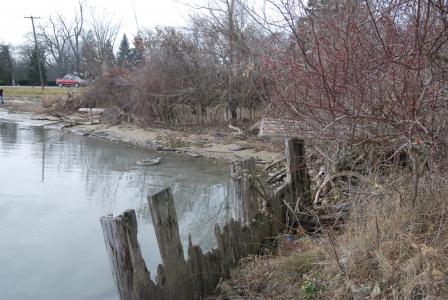 Cottreville shoreline prior to restoration
Cottreville shoreline prior to restoration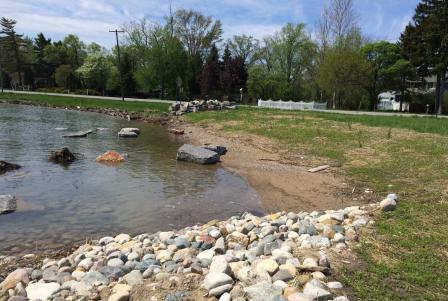 Completed Cottreville Shoreline restoration project
Completed Cottreville Shoreline restoration project
Upper St. Clair River Shoreline Restoration and County Wetlands Park
Approximately 4,300 feet of St. Clair River shoreline was completely rehabilitated and restored in 2013, as part of the Blue Water River Walk. In the spring of 2014, the shallow water habitat restoration effort was completed. During this work, and including the Pilot Phase work done in 2012, almost 7,000 tons of debris was removed from the site. At the southern end, a newly built wetland provides habitat for reptiles, amphibians and waterfowl. Other features include an observation dock, pedestrian trail, outdoor classroom, fishing pier and pubic art as part of the Blue Water River Walk.
Partners: St. Clair Foundation, USFWS, NOAA, USEPA, BPAC (St. Clair River Binational Public Advisory Council), St. Clair County Parks & Recreation, MDEQ
St. Clair River Spawning Reef
Growing to lengths of 7 feet and weighing up to 300 pounds, the lake sturgeon is the largest fish in the Great Lakes. They are classified as threatened or endangered in seven of the eight Great Lakes states.
The St. Clair River is home to the largest remaining Great Lakes spawning populations. Many of the natural limestone reefs and rocky areas that served as spawning grounds were destroyed in the St. Clair River during construction of shipping channels. To increase lake sturgeon, whitefish and walleye populations, a series of river-bottom rock structures suitable for spawning were constructed. Between 2004 and 2015, more than 6 acres of spawning habitat were created at 3 locations in U.S. waters of the St. Clair River.
Helping to determine current sturgeon populations, capture-release tagging studies are performed. During a tagging study, scientists record the sex, length, and weight of each fish caught. In addition to a fin tag, an electronic tag implant is attached. The scientists also harvest a section of the fin ray to determine aging and genetics. Before releasing back into the wild, blood is occasionally taken to for contaminants research.
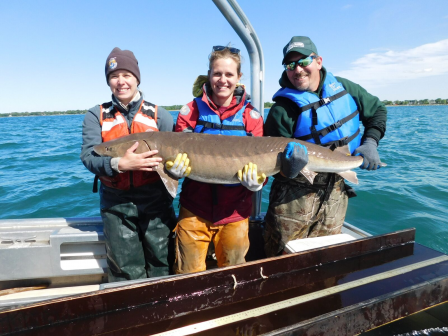 Partners from U.S. EPA, U.S. Fish & Wildlife Service, and Sturgeon for Tomorrow caught this 75-pound female for capture-release tagging study.
Partners from U.S. EPA, U.S. Fish & Wildlife Service, and Sturgeon for Tomorrow caught this 75-pound female for capture-release tagging study.
